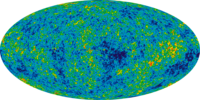
Photo from wikipedia
The sequestering mechanism has been proposed as a remedy to the old cosmological constant problem of the non-gravitating vacuum energy in the matter sector. Here it is shown that an… Click to show full abstract
The sequestering mechanism has been proposed as a remedy to the old cosmological constant problem of the non-gravitating vacuum energy in the matter sector. Here it is shown that an extension of this global constraint mechanism arises naturally from an averaging condition for residual cosmological constants produced in different patches of the Universe. The new mechanism naturally yields the small observed value that gives rise to cosmic acceleration at late times, hence, addressing the new cosmological constant problem. Hereby the halo model picture is adopted with all matter content ultimately residing in the last collapsed structures formed. Sequestering in these collapsing patches produces the desired average residual, where a uniform prior on our present location in the collapse predicts $\Omega_{\Lambda}=0.697$. Finally, a fluctuation of the local residual from the cosmological average can naturally give rise to a locally enhanced Hubble constant.
Journal Title: Journal of Cosmology and Astroparticle Physics
Year Published: 2019
Link to full text (if available)
Share on Social Media: Sign Up to like & get
recommendations!